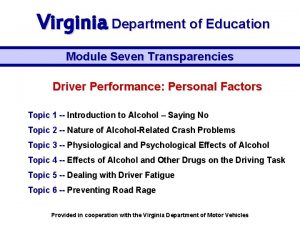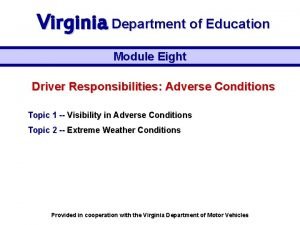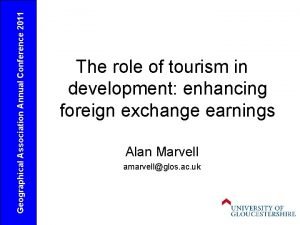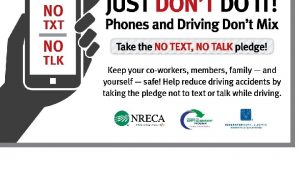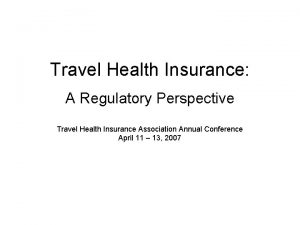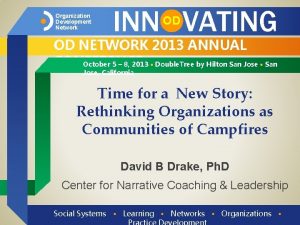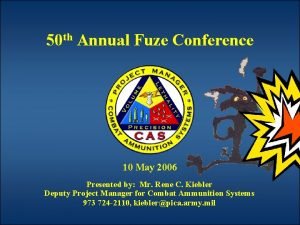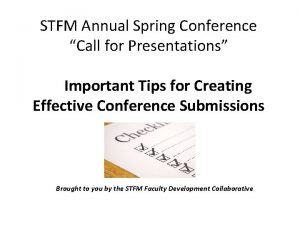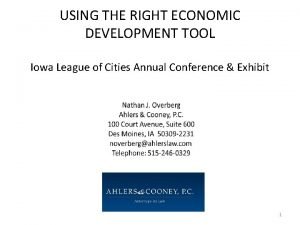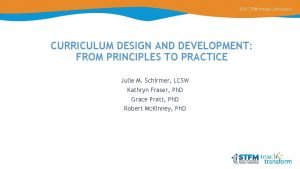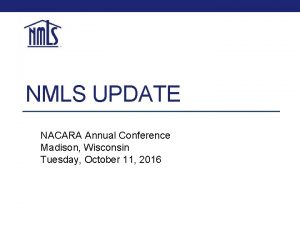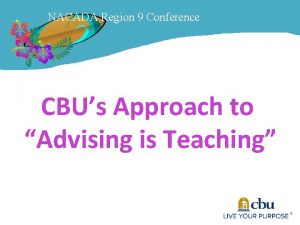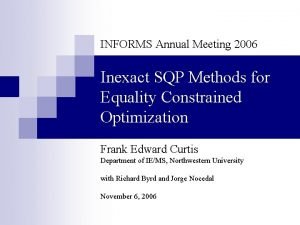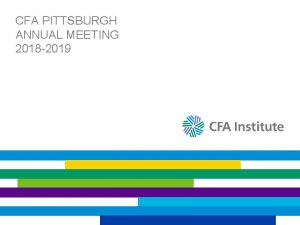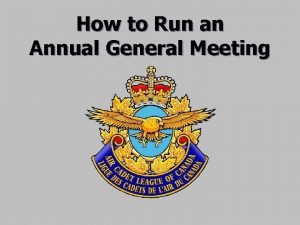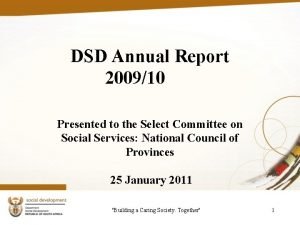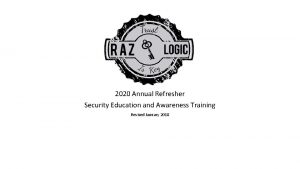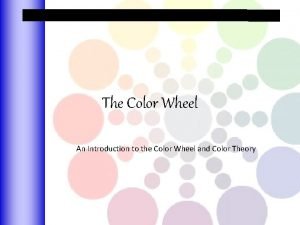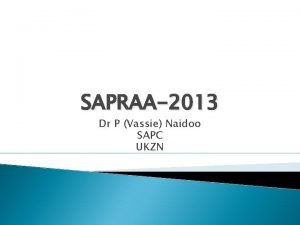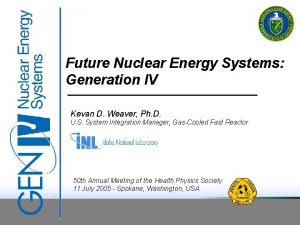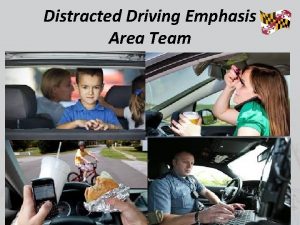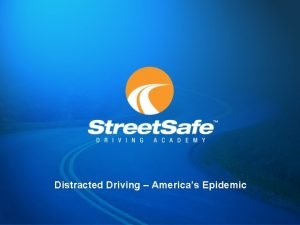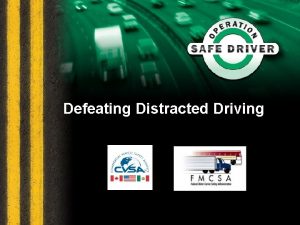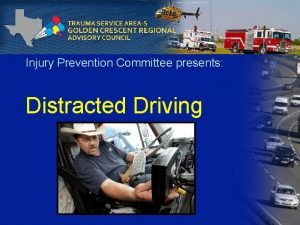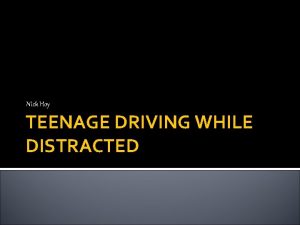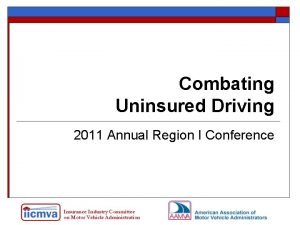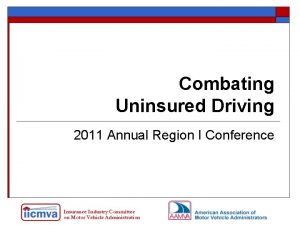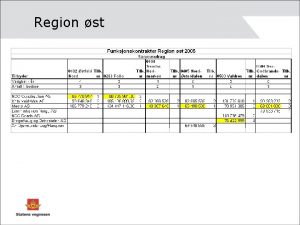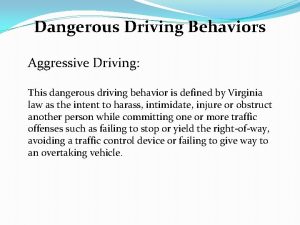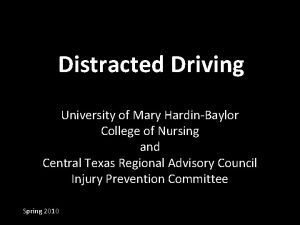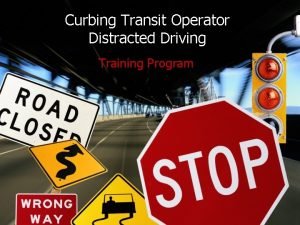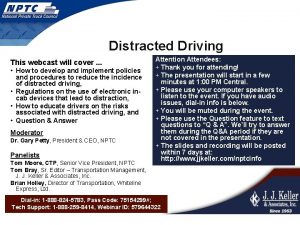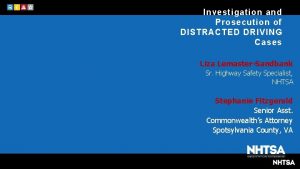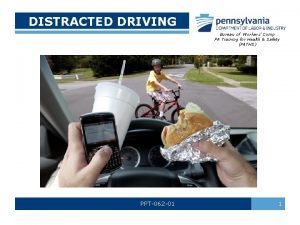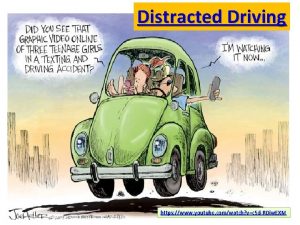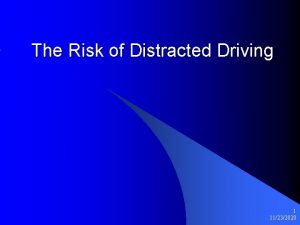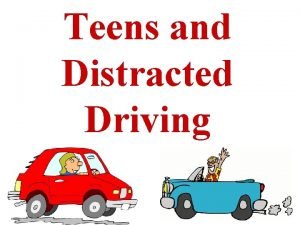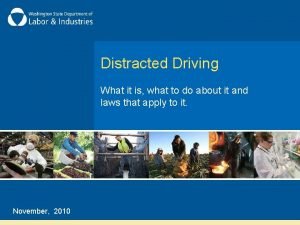Distracted Driving Overview 2011 Annual Region II Conference
































- Slides: 32

Distracted Driving Overview 2011 Annual Region II Conference Charlotte, North Carolina Amy Schick National Highway Traffic Safety Administration

Distracted Driving Problem The under-20 age group had the greatest proportion of distracted drivers In 2009, nearly 5, 550 people were killed an additional 448, 000 were injured in crashes involving distraction, accounting for 16% of fatal crashes. An estimated 20% of injury crashes were reported to have involved distraction.

Distracted Driving Defined Place Photo Here, Otherwise Delete Box Three Types of Distraction: Visual - Eyes off the road Distraction is anything that can take visual, manual or cognitive resources away from the driving task. Distraction occurs when drivers divert their attention from the driving task. Manual - Hands off the wheel Cognitive - Mind off the driving task

Spectrum of Distraction Listening to the radio Texting combines all 3 types of distraction: manual, visual and cognitive distraction

Growing Popularity of Cell Phones About 302 million Americans (96% of all Americans) owned cell phones in 2010, compared to only 1 million in 1987 The National Health Interview Survey found that nearly one in four households were wireless only (no land line), up nearly 2 percentage points from the year before The popularity of text messaging has increased to 2 trillion in 2010, a 31% rise Multiple media service (MMS) increased 64% since 2009 to 56. 6 billion annually. MMS allows users to send videos, pictures, text pages, and ringtones. At the same time, minutes of use increased to 2. 2 trillion.

Relative Risk Most crashes involve a relatively unique set of circumstances that make precise calculations of risk for engaging in different behaviors very difficult. Available research does not allow us to precisely determine what is the riskiest behavior. Different studies and analyses have arrived at different relative risk estimates for different tasks. However, they all show elevated risk when the driver is distracted. Greater Exposure = Greater Risk

Distracted Driving Equal Opportunity Problem At any given moment during the daylight hours, over 672, 000 vehicles are being driven by someone using a hand-held cell phone. People of all ages are using a variety of hand-held devices, such as cell phones, mp 3 players, personal digital assistants, and navigation devices, when they are behind the wheel. Driver Distraction impacts: • Men and women • People of all ages • All Vehicle types

State Text Messaging Bans June 2011 ME WA ND MT VT MN OR ID WI SD WY UT CA AZ CO IL KS OK NM IN MO MA CT RI MI IA NE NV NY NH PA OH WV KY NJ DE MD VA DC NC TN SC AR MS AL GA TX LA AK FL PR Primary HI (all drivers) Secondary (all drivers) Novice Drivers - Primary

Distracted Driving Laws Hand Held Cell Phone Bans in the U. S. California Connecticut Delaware Maryland District of Columbia New Jersey New York Oregon Washington Virgin Islands Except for Maryland, all these laws are primary enforcement— An officer may cite a driver for using a handheld cell phone without any other traffic offense taking place

NHTSA Driver Distraction Program Plan NHTSA has implemented a multi-year Distraction Plan and Research Agenda that will further examine driver communications and entertainment devices, including cell phones, and will also continue to monitor the research of others on this subject.

NHTSA’s Driver Distraction Program Plan NHTSA Goal: Eliminate Crashes Due to Distraction

Distracted Driving Initiative 1 Improve the understanding of the problem: Improve police reporting, analyze additional crash data, continue observational, awareness, hazard anticipation, and naturalistic studies, etc.

Distracted Driving Initiative 2 Reduce workload from interfaces: Develop test procedures to evaluate in-vehicle and nomadic devices. NHTSA will review the extent to which manufacturers are following basic human factors guidelines as well as guidelines put forth by the Alliance of Automobile Manufacturers.

Distracted Driving Initiative 3 Keep distracted drivers safe: Improve crash warning systems.

Distracted Driving Initiative 4 Recognize risks and consequences: Assess the effect of highvisibility law enforcement and targeted media campaigns.

Distracted Driving High Visibility Enforcement Demonstration In April 2009, NHTSA initiated distracted driving demonstration programs in two communities to test whether a high visibility enforcement (HVE) model could reduce two specific instances of distracted driving -- talking or texting using a hand-held cell phone. Syracuse, New York, and Hartford, Connecticut, conducted the demonstrations. The demonstrations spanned over four waves: (March 2010, July 2010, October 2010 & March/April 2011)

Goals and Objective Test whether a high visibility enforcement model reduces instances of talking or texting on a hand-held cellular phone while driving. Will the approach persuade motorists not to talk/text on hand-held phones while driving? Will law enforcement be able to observe violations? Will the approach affect motorists’ perceived risk of receiving a fine for violating the ban?

Click It or Ticket Model The approach used in distracted driving demonstration project was based on the proven Click It or Ticket (CIOT) model. This model involves aggressive enforcement activities that are readily apparent to motorists. The enforcement activity is coupled with paid and earned media developed to alert the public of the enforcement with the end goal being deterrence. These techniques have been highly successful in increasing safety belt use and reducing impaired driving nationwide in the past decade.

Eligibility Criteria: üPrimary enforcement hand-held cell phone bans for all drivers üCapacity to participate immediately in a large-scale demonstration project and contribute the adequate funding and staffing üImplemented in a mid-size city with a population between 100, 000 -250, 000 to provide the best combination of sample size and operational feasibility üLaw enforcement agencies within the selected cities must have a cell phone policy in place for their officers

Tagline and Logo 20

Earned Media and Outreach � Earned Media ◦ Articles ◦ Media ride along � Outreach Materials ◦ DDEP Flyers ◦ DDEP ticket folders ◦ DDEP lens cleaning cloths

Law Enforcement Involvement Law enforcement involvement was the key to the project’s success. Uniformity of purpose by all involved agencies was vital to the perception of the public. Mixed messaging was a common complaint among citizens.

Hartford, CT Law Enforcement Tactics The participating agencies had great success with focused patrols. This strategy employed the use of a spotter in an inconspicuous location or dressed in plain clothes. Law enforcement stressed the importance that the spotter be 100% sure the drivers was using a mobile device before notifying the ticketing officers.

Syracuse Law Enforcement Tactics The participating agencies had success with roving patrols. Agencies reported the use of unmarked vehicles increased their ability to detect motorist who were texting or talking while driving. Higher vantage point SUVs in observation locations were very helpful in increasing an officer’s line of sight.

Observational, Attitude & Awareness Surveys � Road side spotters � Local Department of Motor Vehicle Offices for Pre and post wave awareness surveys 13

What We Learned… “…Good laws coupled with tough enforcement can reduce deadly distracted driving behavior” – Transportation Secretary Ray La. Hood

What We Learned… � Awareness about cell phone use and texting was remarkably high. � The messaging campaigns were successful in disseminating enforcement message. � Enforcement was strong; police in both sites issued a large number of tickets in both sites, many times above previous benchmark levels. � Officers are developing best-practices for enforcement (e. g. , observing texting violations is difficult for an officer who is standing on the side of the road but successful from higher observation points or SUVs, developing easy to use reporting forms).

Behavioral Approach Public Awareness Campaign Federal Employee Texting Ban Federal Ban on Texting for Commercial Truck Drivers Sample Law to Prohibit Texting While Driving FRA Distracted Operator Final Rule PHMSA Texting Rule “Every time we climb into the driver’s seat, we all have a responsibility for keeping our roads safe by putting away cell phones and other distractions. ” - Transportation Secretary Ray La. Hood

Statewide Distracted Driving Demo In FY 2011 NHTSA will build upon the success of the community-based pilot demonstration projects and will initiate two statewide high visibility enforcement campaigns � States that have enacted a primary hand-held cell phone and texting ban* to reduce distracted driving are eligible � *Presently CA, CT, DE, NJ, NY, OR and WA are eligible to participate because they have enacted primary hand-held cell phone and texting ban � NHTSA will further evaluate the widespread application of the high visibility enforcement model to ascertain its effectiveness to raise public awareness about the risks of distracted driving. � NHTSA is collaborating with FMCSA to incorporate commercial motor vehicle components into the statewide demos.

Partnerships � DOT continues to strengthen existing partnerships and build new partnerships to spread the word about distracted driving issues, data and resources. � Secretary La. Hood and the National Safety Council (NSC) helped launch Focus. Driven, the first national nonprofit organization devoted specifically to raising awareness about the dangers of Distracted Driving. � DOT will partner with the Network of Employers for Traffic Safety (NETS) during Drive Safety Work Week in October 2011 to raise awareness (thru employee networks) about the dangers of distracted driving. � DOT will partner with the Better Business Bureau (BBB) to promote employer resources.

DISTRACTION. GOV - Tools You Can Use Insert Calling Plan Ad DOT Action Research and Data Stats and Facts Campaign Tools State Laws FAQ’s Media Insert BAM Enforcement Ad

Questions
 Module 7 topic 1 distracted driving
Module 7 topic 1 distracted driving Module 8 topic 1
Module 8 topic 1 Gcyf 2011 annual conference
Gcyf 2011 annual conference Driving noun
Driving noun Travel health insurance association annual conference
Travel health insurance association annual conference Od network
Od network Gie annual conference
Gie annual conference 2017 dvhimss annual fall conference
2017 dvhimss annual fall conference Nacada annual conference
Nacada annual conference Annual fuze conference
Annual fuze conference Stfm abstract submission
Stfm abstract submission Iowa league of cities annual conference
Iowa league of cities annual conference Hepi conference
Hepi conference Pbfeam
Pbfeam Afp annual conference 2020
Afp annual conference 2020 Stfm annual conference
Stfm annual conference Nmls resource center
Nmls resource center Elisabeth brinton
Elisabeth brinton Nacada region 9 conference
Nacada region 9 conference Triangular interval
Triangular interval Active region and saturation region
Active region and saturation region Informs annual meeting
Informs annual meeting Given that 1 kcal of heat is required
Given that 1 kcal of heat is required Cfa annual 2019
Cfa annual 2019 How to run an annual general meeting
How to run an annual general meeting Nominal interest rate
Nominal interest rate Dsd annual report
Dsd annual report Annual security awareness refresher
Annual security awareness refresher Grade 11 annual teaching plan
Grade 11 annual teaching plan Color red meaning
Color red meaning Lady fern adaptations
Lady fern adaptations Sapc annual declaration
Sapc annual declaration Annual energy outlook
Annual energy outlook
